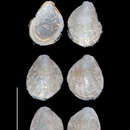en
names in breadcrumbs


“Philobrya atlantica, new species.
Shell small, thin, short-mytiliform, covered with a conspicuous, thin, greenish epidermis, prominent on the ribs and at the margin; valves rather inflated, the beaks crowned with the subovate glochidial valves of the nepionic young, bordered by a narrow elevated margin, then smooth and inflated for a short distance, then radiately ribbed, with about 11 squarish elevated ribs, marked with projecting epidermis, between which the margin is slightly excavated; anterior end short, projecting a little beyond the beaks; area linear, amphidetic; ligament internal, short, almost terminal; interior of valves smooth, the hinge line rather broad, edentulous; the scars as in Mytilus; the byssal gape very narrow. Length of shell, 4; breadth, 3; diameter, 2 mm.
U.S. Fish Commission station 2770, off Spiring Bay, Argentine coast; attached to seaweed dredged in 58 fathoms.
Type. – No. 97057, U.S.N.M.
This little species is interesting as being the first marine Pelecypod in which the existence of a glochidium stage was recognized. An examination of P. setosa, Carpenter, from Cape St. Lucas shows that it agrees in this particular. The genus was originally named Bryophila, which proved to be preoccupied, and was changed to Philobrya.1 The genus is apparently related to Pteria, rather than to Pinna, as supposed by Carpenter.
1Smithsonian Miscellaneous Collections, X, No. 252, Mollusks of Western North America, by P.P. Carpenter, index, p. 21, December, 1872.”
(Dall, 1895)